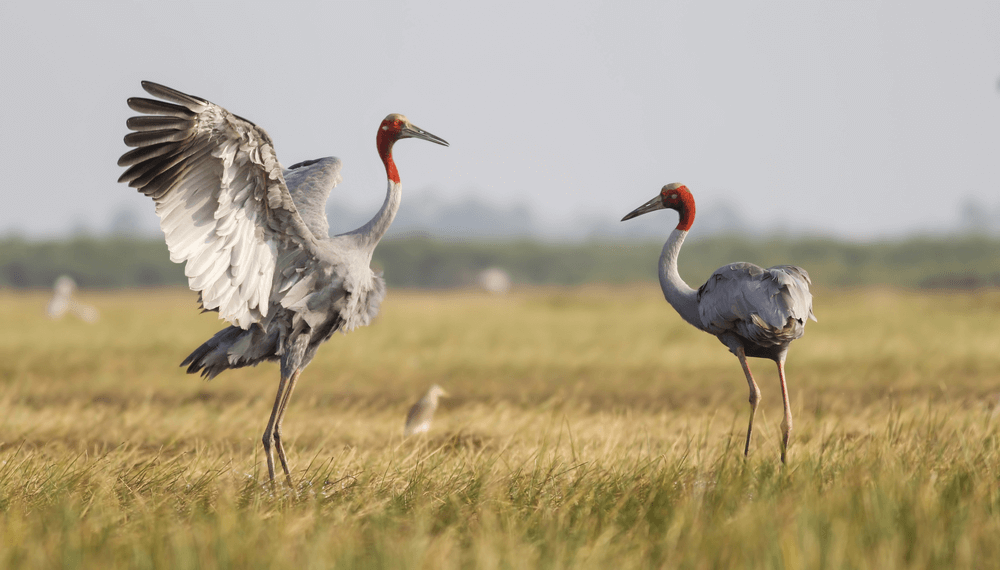Far away from the hustle of mankind, there exists a separate world where birds chirp their way to happiness. Birdwatching, a hobby that is increasingly becoming popular, is all about finding a quiet corner in the midst of nature and silently observing the birds go about their everyday business. Everything about birdwatching, from the chirping sounds to singing tunes, takes the mind closer to the soul, instantly filling you with happiness unbound. So, what is the best part about being a bird watcher in India? You don’t have to look far, or burn a hole in your pocket. A weekend away from home is enough to learn all about birds and a few lessons about unity and diversity. India, a home to incredibly rich fauna, offers a lot of birding locations in all parts of the nation. Want to find out some birding locations near Delhi NCR –please come to Sultanpur Flats!!
Most people associate birds with forests. At the least, they expect a green area earmarked as a sanctuary, or a water body surrounded by greenery, like Haryana’s Sultanpur National Park. Yet, there is better birding to be had in the fallow and cultivated fields and scrubland behind the park that birders call Sultanpur Flats. And in a place not too far away from Sultanpur, Basai, near what is touted as the region’s next hot real estate zone, developments adjoining the Dwarka Expressway.
There is even better birding to be had along a drainage canal in Najafgarh. The Aravalli Biodiversity Park, Basai, Sultanpur, Bhindawas, Dighal—all are probably hotspots in the Central Asian Flyway, a migratory path from Europe and Central Asia to the Indian peninsula that birds have been using for hundreds, maybe thousands of years. A few of the hotspots have become national parks. Many are privately owned agricultural land or commons.
After a heavy shower last night in a pleasant cloudy morning myself, Mahesh and Pawan started from Akshardham Temple to meet and pickup a very enthusiastic birder from London Ms. Emma Juxon from Holiday Inn, Aero city, Delhi for Dawn To Dusk Birding. As we reach at hotel informed her regarding our arrival, after few moments she came down and meet us at hotel lobby. We welcome her with warm Indian style greetings that is “Namaste” and welcome to INDIA. Than we started our journey towards Sultanpur Flat Area – Paradise of Birds. As soon as we started we informed Mr. Sanjay who is our senior naturalist based at Jhanjraula Village adjoined to Sultanpur National Park area about our estimated time of arrival. Which is 55 minuets from Holiday Inn. On the way we shared the birding experience with Ms. Emma who has already 6000+ birds in her book came first time in India and every birds will be lifer for her on that particular day of birding. So we started to show her every birds on the way like House crow, bank myna, black kite, house sparrow and other commoners.

After 55 minuets journey we reached the exit point of village where Mr. Sanjay is already waiting for us, after a small introduction session with Ms. Emma we proceed to near by village to see the weaving process of nesting of Baya Weavers . After spending round about 15 minuets to see the process which was really delightful we proceed to flats area for the show stopper bird from last few weeks in NCR that is “RAIN QUAIL”, on route Ms. Emma enjoyed the view of Indian Village Culture like Mud houses, Cows, Buffalo’s etc. On route we are lucky to see the state bird of Haryana Black Patridge aka Black Francolin (Local Name Kala Titar) with macho sings a automated Ram Tere Kudrat from a mound. In that same area we found Grey Patridge, Indian bush Larks, Kotwal- The Black Drongo and a pair of Wire Tailed Swallow justified their name sitting on a Electrical Wire.

As soon as we enter the flat area adventure started when our car stucked in muddy field. After tried hardly by all of us when we failed to come out from problem we came to see the kindness & dedication of care ness towards their guest by local people, at first Mr. Sanjay called up some local people to join the rescue operation. Some of Delhi birders who are already in that area for birding also came to help us to overcome from situation, but due to wet soil we are unable to do the same so finally Mr. Sanjay went to request the village farmer who is already doing the farming work with tractor to help us and as usual he showed his kindness and came for rescue the car, in between that Ms. Emma, Mahesh & me we all are searching for Rain Quails by walking. There was call of quails coming from every where and due to our foot step noise 02 of then flew away and we had a chance to see beauty of the bird and flying pattern. Here we found another small beauty Zitting Cisticola purged on a tall grass. As soon as car got rescue we started our birding and saw a big flock of greater flamingo, black breasted weaver, common babblers, bengal bushlark and many more. Within 15 minuets time we are lucky to find the show stopper bird – RAIN QUAIL coming out from bush. After giving 5 to 7 minuets display he again entered to the other bush. Than we proceed for the other side of flats, on the way we had our home made breakfast and fresh fruits which we carried with us from Delhi. We enjoyed hot tea in a clean and hygienic road side Dhaba.

After breakfast we proceed for other part of flats, on the way we saw a flock of Wire tailed swallow justified their name as siting on electrical wire, a solo black winged kite looking for his prey and a Knob billed duck continuously forging surrounded by waders. The most beautiful things to watch that all birds are in breeding plumage. On our way back to explore the back side village area of Sultanpur National Park we saw a house of Spotted Owlet (04 Numbers) and a family of Indian Thick Knee.

While going towards the famous Stoliczka’s Bushchat point I personally disappoint to see that the pond on right side which is very famous for Ducks, Painted Snipe and more was empty. Continue to explore the flat we saw Grey Backed Shrike, Scaly breasted munia and many more. Before lunch we explored the part of Najafgarh Jheel & Chandu (Near water filter plant area). At Najafgarh we saw round about 100o+ Oriental Pratincoles on flight and a beautiful nest of Indian golden oriole with chicks, it was really a pleasant sighting.

For Lunch we reached at Rosy Pelican Restaurant which is adjoint to Sultanpur National Park. They served hot & excellent Indian food. Ms. Emma really enjoyed the Charcoal oven grilled chicken (Tandoori Chicken) with Butter Naan. After having the nice meal we proceed for second half birding at Aravali Bio Diversity Park, Gurgaon.

About The Park:
Aravali Biodiversity Park, Gurgaon is an absolute hidden gem right in the heart of the city. It is spread over 153 hectares in a rocky terrain and is situated very near to Guru Dronacharya metro station. The park in the 90s was used as mining quarries which resulted had in serious degradation of native flaura and fauna species. In 2010, the park was restored by a group of citizens called “IAmGurgaon”. It is said that currently the park has 160 species of native plants and over 175 bird species along with few other small vertebrates species. No wonder, this is one of the best places in Gurgaon for nature lovers!

After reaching at park we waited for round about 45 minuets due to heavy rain. As soon rain stop we started for explore the park area and welcomed by White eared bulbul and a pair of pied cuckoo. After 15 minuets walk we reach at Savana Night Jar Point, there we saw the hide and seek chasing between Dogs & and Indian hare, enjoyed the full show how hare makes the dogs fool and ran away.
Now the time for going back to our nest we started heading back to parking area, hey wait…….. still its not end of the day just before 500 meters from the gate A bird flew away with red billed guess what , It was Sirkeer Malkoha. After watching the bird for 10 minuets we ended our a great day of birding.
We reached at Hotel Shanti Palace which was pre booked for Ms. Emma and after done the check in procedure we see off each other. End of a great and fruitful day of birding.
Please find the below list for the birds we sighted and heard…
1. Black francolin
2. Grey francolin
3. Rain quail
4. Lesser whistling Duck
5. Knob billed duck
6. Indian spot billed duck
7. Little Grebe
8. Greater flamingo
9. Red napped ibis
10. Black headed ibis
11. Indian pond heron
12. Cattle egret
13. Intermediate egret
14. Great cormorants
15. Little cormorants
16. Black kite
17. Black winged kite
18. White eye buzzard
19. White breasted waterhen
20. Barred button quail
21. Purple Swamp hen
22. Common moorhen
23. Eurasian coot
24. Indian thick knee
25. Black winged stilt
26. Yellow Wattled lapwing
27. Red Wattled Lapwing
28. Ruff
29. Black tailed godwit
30. Wood sandpiper
31. Common sandpiper
32. Little stint
33. Oriental Pratincole
34. Rock pigeon
35. Eurasian collard dove
36. Red Turtle Dove
37. Laughing Dove
38. Rose ringed parakeet
39. Jacobin cuckoo
40. Asian koel
41. Greater coucal
42. Spotted owlets
43. Indian roller
44. Common hoopoe
45. White Throated kingfisher
46. Green Bee eater
47. Blue chucked bee eater
48. Long tailed shrike
49. Bay back
50. Southern Grey
51. Black drongo
52. Indian golden oriole
53. House crow
54. Plain Martin
55. Wire tailed swallow
56. Streak throated swallow
57. Red rumped swallow
58. Indian Bushlatk
59. Bengal bushlark
60. Crested lark
61. White eared bulbul
62. Red vented bulbul
63. Graceful prinia
64. Ashy prinia
65. Plain prinia
66. Zitting cisticola
67. Striated babbler
68. Common babbler
69. Jungle babbler
70. Large grey babbler
71. Bank Myna
72. Common Myna
73. Asian pied starling
74. Rosy starling
75. Indian Robin
76. Oriental Magpie Robin
77. Pied bush chat
78. Brown Rock chat
79. Purple Sunbird
80. House Sparrow
81. Sind Sparrow
82. Yellow throated petronia
83. Black breasted weaver
84. Baya weaver
85. Indian silverbill
86. Scaly breasted Munia
87. Paddy field pipit
88. Indian peafowl
89. Blyth’s Reed warblers
90. Sirkeer Malkoha
91. Blue tailed bee eater











